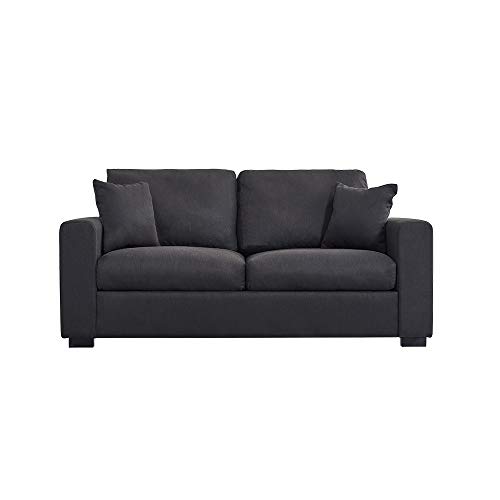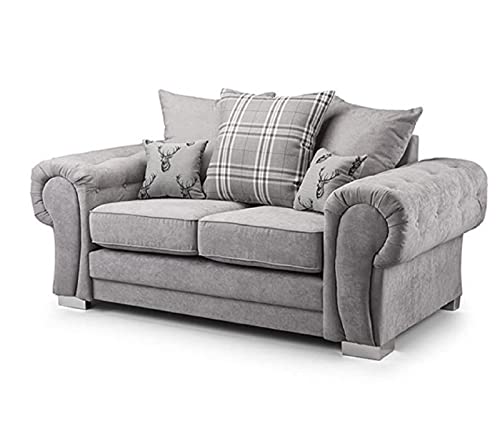Guide To 2 Seater Leather And Fabric Sofa: The Intermediate Guide To 2…
페이지 정보
작성자 Lavonne 작성일 25-01-18 05:31 조회 14 댓글 0본문
 Choosing Between a 2 Seater Leather and Fabric Sofa
Choosing Between a 2 Seater Leather and Fabric Sofa It can be difficult to choose between leather and fabric when you are looking for a new sofa. This is especially true if you don't have much furniture experience.
It can be difficult to choose between leather and fabric when you are looking for a new sofa. This is especially true if you don't have much furniture experience.If you have children or live in a smaller apartment the leather option might be the best choice for you. It's easy to wipe down and looks fantastic in a lot of homes.
Comfort
A sofa is the focal feature of many people's living areas and is a major purchase. You want a sofa you can sit on for a long time and that looks good, and that will last the test of time. Deciding between leather or fabric isn't easy However, it is essential to assess your priorities and lifestyle before making a decision.
Leather is a luxurious material that has a luxurious feel and oozes elegance in the home. It is strong, stain-resistant, resistant to pets and children, and will last for a long time if properly cared for. It is expensive in the beginning and may require regular conditioning to avoid cracking or peeling.
Fabric sofas come in a variety of styles, colours and fabrics. They can be a more affordable choice than leather ones. They are also softer and more welcoming, with the ability to feel "broken in" from the beginning. They are more prone to dust mites and pet hairs and require frequent cleaning. There are now hypoallergenic fabrics and new technologies that are available.
Fabric sofas can last up to 15-years if they are well maintained. Regular vacuuming and deep cleaning will aid in keeping the fabric clean and free of odours and spills. Like leather, they can be susceptible to flattening and sagging over time. Many fabric couches are treated with chemicals to make them stain resistant and flame retardant. These can release volatile organic compounds that can alter indoor air quality and cause allergies.
Durability
We typically choose sofas with fabrics that are durable, particularly if you have children or pets. You don't have to spend lots of money up front when you're likely to regret it after the first stain or claw. Similarly you shouldn't purchase something that is cheap but can't withstand daily use.
Leather, on the other hand is extremely tough and has a remarkable tear strength. It can last up to four times longer than fabric and it is naturally resistant to cracking, fade and flaking over time. It can also be treated to restore its natural oils and look as good as new.
Fabrics are cheaper and come in a variety of colors, patterns, and textures that can be adjusted to any design scheme. They are also cleaner than leather and can withstand a significant amount of wear and tear, however they tend to be more prone to moisture and can be susceptible to fading as time passes.
Microfiber is tough and comes in a variety of colors. However, it might not be as durable as genuine leather. It may also not be able of enduring scratches. But, it's an ideal choice for families because of its resilience to stains and spills and it is easy to clean generally with a damp cloth.
Suede is more difficult to clean and repair than leather. It also can lose its shape if not conditioned and can feel quite rough to the feel. It's also a very thin substance, so it may not be as durable as sheepskin or cowhide leather.
Allergens
Fabrics can have a significant impact on allergies. It is important to understand how different options perform. Fabrics tends to retain allergens like dust mites and pet dander, which can trigger symptoms such as asthma, hay fever eczema, and rhinitis. This is due to the fact that these fabrics act as an ideal environment for them to fester.
However, leather, unlike other materials is not a source of allergens and can provide consistent comfort, regardless of the season. However, it can also be a trigger for skin irritation, especially in those suffering from contact dermatitis and are sensitive to the chemicals that are used in the tanning process. To minimize skin reactions, it's essential to use products made from vegetable oils and keep a consistent skincare routine.
Sofas made of leather and fabric have a high level of durability, but the type of 2 seater fabric settee you choose will determine the degree to which it can last over time. A good quality fabric will stand up to everyday usage without fading or sagging and will resist spills and body oils with ease. Many modern couches come with stain-resistant treatment to make cleaning easy.
While you might not be able to completely avoid an allergic reaction to the leather sofa, it can help to prevent allergens from forming by having a lint roller close by and regularly vacuuming your living area. This can help reduce the amount of pet hair, dirt and dust mites that gather on your sofa. If you're still suffering from allergies, you can replace your sofa with a hypoallergenic one. For example, a leather sofa made from vinyl or synthetic leather is less likely to hold dust mites and pet dander. It also will allow you to breathe easier.
Scratches
It is crucial to think about the amount of wear and tear you can expect the leather sofa to endure. The amount of time a sofa is expected to last depends on the finish, colour and leather quality. You must also ensure it's sturdy enough to withstand spillages or other accidents. You can accomplish this by looking for a couch with a sturdy wooden frame and high-density foam cushions.
Leather can be damaged for a number of reasons, like stretching and marking the territory or recovering stress. Scratches can be severe in severity, ranging from small 2 seater fabric sofa surface scratches to large cuts and punctures. Minor scratches can be fixed by using a leather conditioner. This will help to restore the equilibrium of moisture and oil in the leather, preventing drying out and cracking. Cuts and scratches that are deep might require a different treatment based on the severity of damage.
If you have cats, it is recommended to trim their nails regularly as this can aid in preventing scratching on your couch. You can also redirect their scratching behaviour by giving them alternative scratching surfaces like sisal rope or cardboard. Another option is using a pet-safe furniture polish, which can be applied with an abrasive cloth to the affected area.
It is important to wash your leather sofa regularly and keep it out of direct sunlight and heat as they can dry it out. This could cause cracks in the leather. Repairing this can be difficult and requires reupholstery. Make use of a leather conditioner in order to keep the leather supple.
Smell
A leather 2 seater sofa fabric is likely to have a different scent than fabric. It's because leather is porous and absorbs odors such as body odors, smoke or food. The good news is that odors usually dissipate with time, especially when you use a nontoxic cleaning product that is fragrance-free.
However, if the smell is strong, it could mean there's something wrong with the foam. This is often caused by chemical off-gassing resulting from petroleum-based polyurethane. If this is a concern you should look for couches made from CertiPUR US certified or natural latex.
Another way to tell if it's faux leather is to feel for bumps or texture on the back of a sofa. This is a sure sign that it's bonded, not genuine top grain leather. It is also possible to conduct an inspection by tilting the couch to its side to see if it's possible to see any visible upholstery backing. If it is detect any visible backing, it's likely a synthetic material like polyester or polyurethane, which will have a very different smell than true leather and fabric 2 seater sofa.
Regularly cleaning your leather sofa will keep it in good condition and smell great. This will keep it looking great and smelling good and will also stop it from becoming stiff or cracked over the years. Begin by vacuuming and dusting the couch before wiping it down with a dry cloth and baking soda (a good natural way to get rid of the smell). You should do this at least every two weeks or more to get rid of dust and dirt build up. Apply leather conditioner to preserve the color and texture of your sofa.
댓글목록 0
등록된 댓글이 없습니다.
